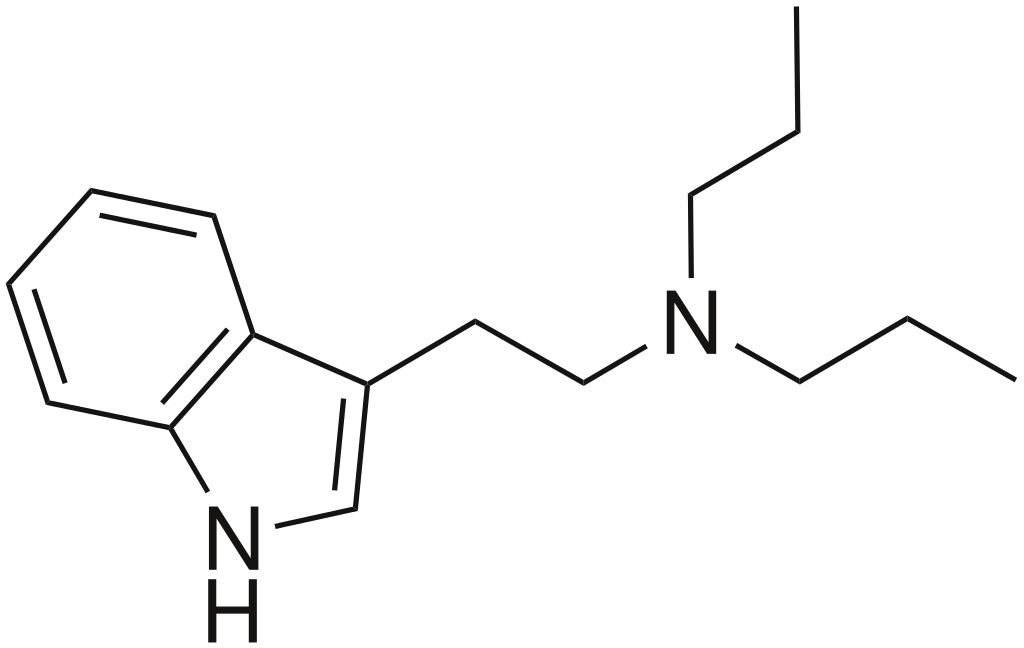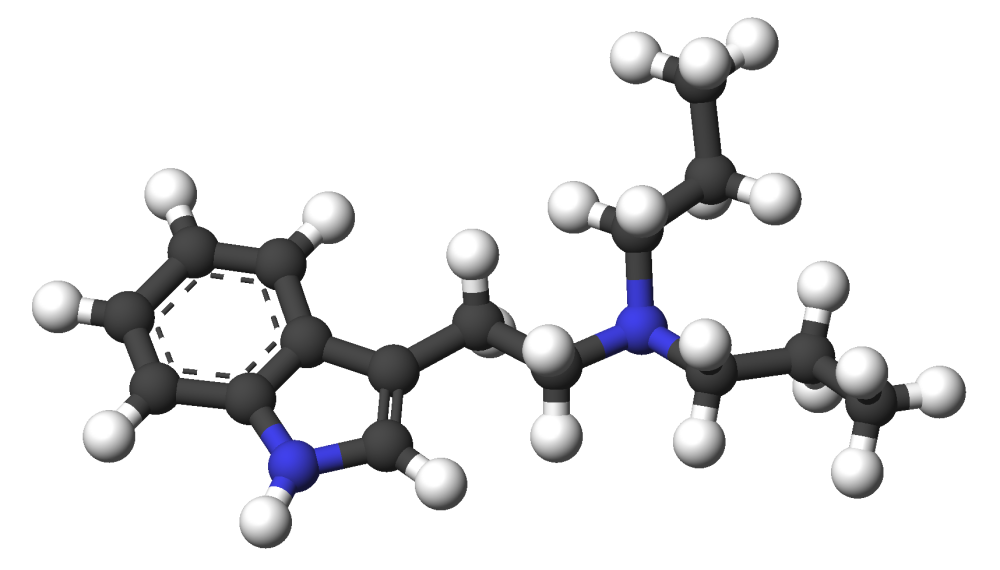Contents
Summary
N, N-Dipropyltryptamine (DPT) is a member of the tryptamine family, known for its psychedelic and entheogenic properties. Although law enforcement officials have noted its use as a designer drug as far back as 1968, its potential therapeutic applications were explored in the 1970s. DPT is typically encountered in the form of a crystalline hydrochloride salt or an oily or crystalline base and has not been identified as an endogenous compound. It shares a close structural resemblance to dimethyltryptamine (DMT) and diethyltryptamine (DET).
When consumed, common physical effects may include sensations of nausea, numbness in the tongue or throat, and dilation of the pupils.
| Identifiers | |
|---|---|
| IUPAC name | |
| CAS Number | 61-52-9 |
|---|---|
| PubChem CID | 6091 |
| ChemSpider | 5866 |
| UNII | S7272VWU50 |
| CompTox Dashboard (EPA) | DTXSID30209847 |
| Chemical and physical data | |
| Formula | C16H24N2 |
| Molar mass | 244.382 g·mol−1 |

Pharmacology
Research conducted on rodents has demonstrated that the behavioural effects of DPT can be effectively blocked by a selective 5-HT2A receptor antagonist. This finding strongly suggests that the 5-HT2A receptor plays a crucial role in the action of DPT. Additionally, the modulatory effects of a 5-HT1A receptor antagonist imply that there is also a 5-HT1A-mediated component involved in the actions of DPT.
Chemistry
DPT changes Ehrlich’s reagent violet and causes the marquis reagent to turn yellow.
Psychedelic properties
Despite its chemical similarity to dimethyltryptamine (DMT), dipropyltryptamine (DPT) exhibits distinctly different psychoactive effects.
Side effects
The consumption of this substance by humans can lead to adverse effects, such as elevated heart rate, dizziness, anxiety, panic, confusion, paranoia, delusions, and, in rare instances, seizures and nausea. There has been a reported case of at least one death associated with seizures where the use of dipropyltryptamine was implicated. However, it’s important to note that comprehensive details are lacking, and the drug has not been definitively confirmed as the sole cause of death.

Legal status
United Kingdom
DPT is categorized as a Class A drug in the United Kingdom, rendering its possession and distribution illegal.
United States
At the federal level in the United States, DPT is not scheduled.
However, it could be treated as an analog of substances like 5-MeO-DiPT, DMT, or DET under the Federal Analogue Act, resulting in potential prosecution for purchase, sale, or possession.
Florida
In the state of Florida, “DPT (N,N-Dipropyltryptamine)” is classified as a Schedule I controlled substance, making it illegal to buy, sell, or possess.
Maine
DPT is also classified as a Schedule I controlled substance in the state of Maine, where its purchase, sale, and possession are prohibited.
Sweden
As of 26 January 2016, DPT is considered illegal in Sweden.
FAQ
- What is Dipropyltryptamine (DPT)?
- Dipropyltryptamine, commonly known as DPT, is a psychedelic entheogen from the tryptamine family. It is chemically similar to dimethyltryptamine (DMT) and diethyltryptamine (DET). DPT has been studied for its psychoactive effects and potential therapeutic applications.
- How does DPT differ from DMT and DET?
- While DPT shares structural similarities with DMT and DET, its psychoactive effects are notably different. Users often report unique sensory and perceptual experiences distinct from those associated with DMT or DET.
- What are the typical physical effects of DPT use?
- Common physical effects of DPT use include nausea, numbness of the tongue or throat, and pupil dilation. These effects may vary from person to person.
- How does DPT affect serotonin receptors?
- DPT’s mechanism of action is believed to involve serotonin receptors. Specifically, it interacts with the 5-HT2A receptor, which plays a key role in mediating its effects. Additionally, DPT’s actions may also involve the 5-HT1A receptor.
- What are the potential negative side effects of DPT use?
- Negative side effects associated with DPT use may include increased heart rate, dizziness, anxiety, panic, confusion, paranoia, delusions, and, less commonly, seizures and nausea. While there has been at least one case implicating DPT in death due to seizures, it has not been officially established as the sole cause of death.
- Is DPT legal in the United Kingdom and the United States?
- In the United Kingdom, DPT is classified as a Class A drug, making its possession and distribution illegal. In the United States, it is not scheduled at the federal level. Still, it could be considered an analog of certain substances, potentially leading to legal consequences under the Federal Analogue Act. Specific regulations may vary by state.
- Where else is DPT considered illegal?
- DPT is also illegal in certain U.S. states, such as Florida and Maine, where it is classified as a Schedule I controlled substance. Additionally, Sweden banned DPT as of 26 January 2016.
References
- “Microgram Journal Volume One No. 7” (PDF), published by the U.S. DOJ, Bureau of Narcotics and Dangerous Drugs in April 1968, provides early insights into the study of DPT. It serves as one of the foundational references in understanding this compound’s history and properties.
- Grof S, Soskin RA, Richards WA, and Kurland AA conducted research in 1973, exploring “DPT as an adjunct in psychotherapy of alcoholics.” This study delved into potential therapeutic applications of DPT, shedding light on its role in aiding alcoholics in psychotherapy.
- Fantegrossi WE, Reissig CJ, Katz EB, Yarosh HL, Rice KC, and Winter JC’s work in January 2008, titled “Hallucinogen-like effects of N,N-dipropyltryptamine (DPT),” investigated how DPT induces hallucinogenic effects. The study explored the involvement of serotonin 5-HT1A and 5-HT2A receptors in rodents, contributing to our understanding of its pharmacological actions.
- Spratley T’s report from 2004, titled “Analytical Profiles for Five ‘Designer’ Tryptamines,” provided analytical insights into various tryptamines, including DPT. This work has been instrumental in characterizing the properties of designer tryptamines.
- In “Breaking Open The Head” by Pinchbeck D, published in 2003, the author explores the world of psychedelics, including DPT. This book offers a broader cultural perspective on the use of psychoactive substances like DPT.
- An incident reported in “Carver County teen’s death puts spotlight on ease of purchasing synthetic drugs online” (October 2015) highlights the dangers of acquiring synthetic drugs, including DPT, online. This real-life case underscores the importance of regulating such substances.
- The “Temple of the True Inner Light” is a significant resource for individuals interested in entheogenic experiences. It may provide valuable information and perspectives on the use of DPT and similar compounds.
- The “SCHEDULES OF CONTROLLED SUBSTANCES §1308.11 Schedule I,” found in the Code of Federal Regulations (CFR), outlines the legal classification of DPT in the United States. Understanding its legal status is crucial for those considering its use.
- In the Florida Statutes, specifically in Chapter 893, “DRUG ABUSE PREVENTION AND CONTROL,” DPT is classified as a controlled substance. This legal framework has implications for those in Florida who possess, sell, or use DPT.
- “31 nya ämnen kan klassas som narkotika eller hälsofarlig vara” (in Swedish) signifies the efforts of Sweden’s public health agency in November 2015 to classify certain substances, potentially including DPT, as narcotics or hazardous goods. This legislative action reflects international efforts to regulate psychoactive substances.